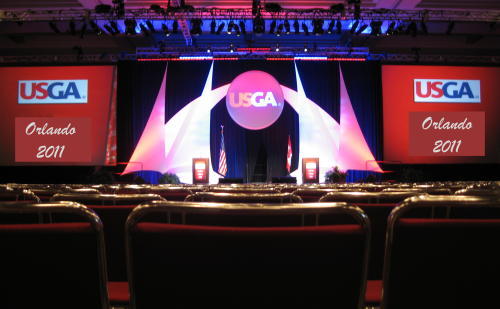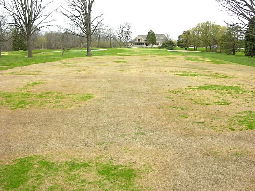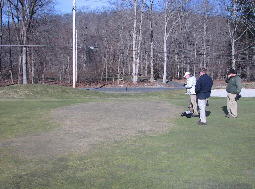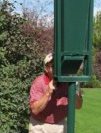The USGA Green Section
Record |
|
|
|
|
March 18, 2011 -- Volume 49, Number 11 |
|
| Green Section Education Conference Presentations | If you were unable to attend the Green Section Education Conference at the 2011 Golf Industry Show we have good news!
by the Green Section Staff |
 | |
Put yourself in the audience at the Green Section Conference held at the
2011 Golf Industry Show |
For the 34th consecutive year, the annual Green Section Education Conference was held in conjunction with the 2011 Golf Industry Show (GIS). This year's program, held on February 11th, addressed the theme, "Lessons Learned Come in All Forms." The Green Section's staff totals 420+ years of experience, and the session highlighted some of the lessons learned and changes witnessed in the turfgrass management field.
We are conscious of the fact that economic challenges have made it more difficult for people to attend the GIS, and, with this in mind, we are sharing the Green Section presentations in this publication. Over the coming weeks you will find written summaries of the presentations and links to the video of the actual conference presentations.
This week includes two presentations:
The Good, The Bad, and The Ugly - the Green Committee Unveiled
Bob Brame, director of the Green Section North-Central Region
Read the article
Watch the video
Best Turf Tip #1 - Nothing Done, Something Gained
Derf Soller, agronomist, Northwest Region (presenter)
Patrick Gross, director, Southwest Region
Jim Skorulski, senior agronomist, Northeast Region
Ty McClellan, agronomist, Mid-Continent Region
Read the article
Watch the video
|
| Is Your Course Environmentally and Economically Sound? | Questions and answers to some of the most serious challenges facing courses today
by the Green Section Staff | |
 The game of golf faces two difficult issues affecting every course in the country - environmental and economic sustainability - and both require attention. Environmental sustainability is impacted by water and wildlife issues. Economically, the cost of maintenance and shrinking free time for golfers presents challenges. A common obstacle is unrealistic expectations about course conditioning. Fortunately, there is plenty of room to adjust expectations without damaging the integrity of the game. The game of golf faces two difficult issues affecting every course in the country - environmental and economic sustainability - and both require attention. Environmental sustainability is impacted by water and wildlife issues. Economically, the cost of maintenance and shrinking free time for golfers presents challenges. A common obstacle is unrealistic expectations about course conditioning. Fortunately, there is plenty of room to adjust expectations without damaging the integrity of the game.
To help these efforts, the USGA staff has assembled a list of questions that every facility should consider regarding best management practices (BMPs) for sustainability. The goal is to help courses assess their own situation and develop actions to improve. There never will be an end point; the journey is one of continual progress and improvement.
This week's question:
|
| Attention Golf Course Superintendents! | University scientists need your help to evaluate anthracnose
by the Green Section staff |
 | |
Symptoms on turfgrass (left) and microscopic view of the setae of the fungus (right).
Images provided by Dr. Eric B. Nelson, Cornell University. |
Anthracnose continues to plague golf course putting greens. University researchers are asking golf course superintendents to participate in an online survey to help them better understand the challenges presented by this chronic and widespread disease. Your input will provide critical feedback to determine the effectiveness of current management recommendations to reduce anthracnose severity and to develop new research studies to improve disease control. The survey information gathered will be used only for university research.
This survey will provide information to the joint-university research group known as NE 1025, which conducts research to solve problems related to pests of annual bluegrass. The official project is entitled "Biology, Ecology and Management of Emerging Pests of Annual Bluegrass on Golf Courses." Formed in 2005, this research group has expanded the knowledge of the fungus-causing anthracnose, and identified cultural and chemical practices to minimize its severity.
Members of the NE 1025 anthracnose research project represent the: University of California-Riverside; University of Connecticut; Cornell University; University of Guelph; University of Massachusetts; North Carolina State University; Pennsylvania State University; Rutgers, the State University of New Jersey; and the U.S. Department of Agriculture.
You can help the NE 1025 researchers to better solve the anthracnose problem on golf courses across the country by completing the online survey today at: https://anthracnose.questionpro.com.
Thank you for your participation. NE 1025 researchers also appreciate assistance from GCSAA with this online survey. Results of this survey and future BMPs developed by the NE 1025 group will appear in Golf Course Management magazine.
|
| Don't Procrastinate - Irrigate | |
 A North Central Regional Update A North Central Regional Update
by Bob Vavrek, senior agronomist
It won't be long before all speculation comes to an end about winter injury. No doubt, there will be winterkill to Poa annua somewhere across the upper Midwest. The only questions are "where" and "how severe?"
 | |
Winter injury will be seen somewhere across the North Central Region this spring. Providing ample irrigation to the turf is an essential, but often overlooked, aspect of the recovery process. Initiate irrigation across damaged turf as early as possible to limit further injury from desiccation and to accelerate the rate of recovery from inter-seeding operations. |
Philosophies about the most effective programs for accelerating recovery can vary significantly from course to course. Covers or no covers? Sod or seed? Verticut or aerate to prepare a seedbed? Do it all and torpedo the budget by June, or do nothing and let Mother Nature take her course? After all, an old Poa annua surface is resilient to the point where recovery will eventually occur, regardless of what we do or don't do.
However, a stagnant golf economy dictates that we make every effort to provide golfers a playable surface as soon as possible after a bout of winterkill. Springtime green fees provide extremely important early season cash flow, and a new member who joins a club during April will pay dues the rest of the season. Nothing elicits the response of: "I will play or join somewhere else" quite like the sight of dead greens and fairways and injury that persists through Memorial Day weekend.
| |
Read the rest of this update.
|
|
A Painful Start To Spring | |
 A Northeast Regional Update A Northeast Regional Update
by Adam Moeller, agronomist
 | |
Winter injury has been observed at many golf courses in the region. Keeping the greens closed during the seeding and establishment process is essential for a speedy and successful recovery. |
Many golf courses in the region have lost their snowpack recently and discovered moderate to severe winter damage on putting greens. Adding to the frustration is the fact that March often turns out to be the most damaging month for winter injury because of the frequent freeze/thaw events and rainfall. With luck, Mother Nature won't throw any more challenges our way.
Regardless of damage severity, winter injury is always a painful start to spring. Recovery from winter damage starts with communication. The sooner that course decision-makers and golfers are aware of the damage the better. The following are key steps to promote recovery from winter injury on greens.
Read the rest of this update | |
|
| Green Section Record Archive (digital) | Looking for a previous issue of the Green Section Record?
|
 | |
Looking for something? |
The Green Section Record has been published under various names since 1921 and is composed of an amazing collection of full-text articles and photos. This collection is stored and maintained by the wonderful library staff at Michigan State University in the Turfgrass Information File (TGIF). All past issues of the Record, right up to and including this one, can be accessed free-of-charge by following this link. Search the Green Section Record |
| The USGA Green Section Portal |
A Valuable, Free Resource |
Take a minute to visit the Green Section's portal at http://gsportal.usga.org to find information regarding upcoming live webcasts and links to recordings of more than 30 previously-delivered webcasts and announcements of upcoming USGA Green Section activities, education conferences, and meetings. |
|
|
|
| USGA Green Section
P.O. Box 708
Far Hills, NJ 07931-0708 908.234.2300
| |

©2010 by United States Golf Association®
Permission to reproduce articles or material in the USGA Green Section Record is
granted to newspapers, periodicals, and educational institutions (unless specifically
noted otherwise). Credit must be given to the author, the article's title, USGA Green
Section Record, and the issue's date. Copyright protection must be afforded. To reprint
material in other media, written permission must be obtained from the USGA. In any
case, neither articles nor other material may be copied or used for any advertising
promotion, or commercial purposes.
Green Section Record (ISSN 2156-5813) is published weekly via electronic mail by the
United States Golf Association®, Golf House, Far Hills, NJ 07931.
|
|
|
|
|
|